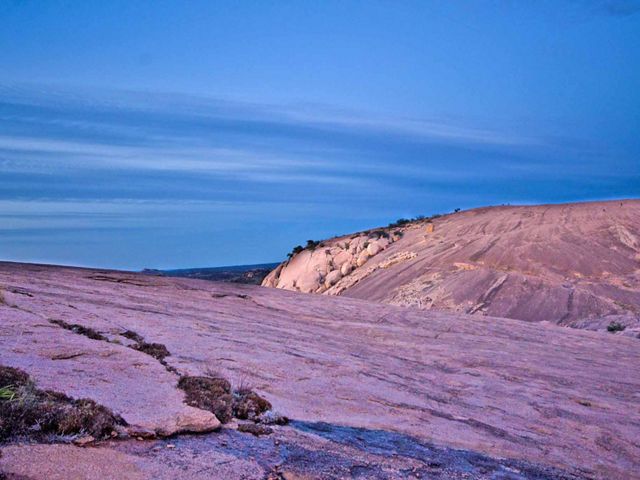Enchanted Rock: A Texas Treasure
In 1978, The Nature Conservancy purchased Enchanted Rock, setting into motion the permanent protection of one of Texas' most beloved landmarks.
More than three decades ago, The Nature Conservancy (TNC) helped establish one of the most popular parks in Texas, protecting the soaring views of Enchanted Rock that look out over the rolling, tree-scattered Texas Hill Country.
The huge pink granite dome that sits as the centerpiece of this park is less than 20 miles from the tourist haven of Fredericksburg, Texas. Now called the Enchanted Rock State Natural Area, hundreds of thousands of visitors clamber up its gleaming rock faces each year to learn about historical legends and ancient geology while experiencing a piece of Texas’ natural heritage.

Part of Texas Lore and Legend
Enchanted Rock, Little Dome, Turkey Peak and other domes cover 640 acres at the state park, which TNC purchased in 1978 at the urging of Lady Bird Johnson. The rock represents a geological phenomenon known as a “batholith” and was created 1.1 billion years ago when molten magma cooled and crystallized into granite far beneath the Earth’s surface. This magma pushed up into the rock lying above it in places, while high winds near the top of the dome—which extends up to 40 stories high—removed the soil and rock that once covered the granite. The batholith's pink granite resembles that quarried nearby in Llano to form the polished façade of the Texas State Capitol building.
While exploring 425 feet above Big Sandy Creek, visitors can look for tiny, translucent shrimp that live in shallow depressions called "vernal pools" during wetter times of the year. They can also observe live oak clusters along trails, listen for songs of canyon wrens near the base of Little Dome and search for many bird species, including Bewick's wren, Carolina chickadee and yellow-rumped warbler.


Here, prickly pear and other cacti along with little bluestem and additional grasses dot the landscape, while endangered leafy rock quillwort fills the transient vernal pools. Down below, buttonbush, switchgrass and muhly occur along Big Sandy Creek. This splendid Hill Country habitat supports wildlife like rock and fox squirrels, as well as armadillos, rabbits and white-tailed deer.
The rock has been called "enchanted" since the 1800s based on various legends, likely stemming from the granite's tendency to creak and groan as it naturally heats up and cools down. The natural area contains small, man-made depressions in the granite where seeds were once ground into flour, and hundreds of archaeological sites exist from human visitation here for thousands of years; 120 of these sites are State Archeological Landmarks. More recent Indigenous Peoples who have a connection to Enchanted Rock include the Lipan Apache, Comanche and Tonkawa—who considered the dome to be haunted by spirits, believed to have the power to cast spells on intruders.

Keeping the Magic Alive
Enchanted Rock was already designated a National Natural Landmark before TNC purchased the 1,640-acre property in 1978. Six years later, it was transferred to the Texas Parks and Wildlife Department for their management, which added three more acres.

The legendary dome was once one of many in a batholithic area encompassing 60 square miles on the border of Gillespie and Llano counties. By setting aside this cultural landmark, TNC helped spare Enchanted Rock from the fate of other exposed batholiths that were heavily quarried to construct buildings and structures such as coastal jetties. More than 250,000 visitors experience the magical views offered atop the granite dome every year, which still stands as the second-largest hill made of bedrock in the United States.
For more information about The Nature Conservancy's work in Texas, including other places we've helped protect, visit nature.org/texas.
We Can’t Save Nature Without You
Sign up to receive monthly conservation news and updates from Texas. Get a preview of Texas' Nature News email.




